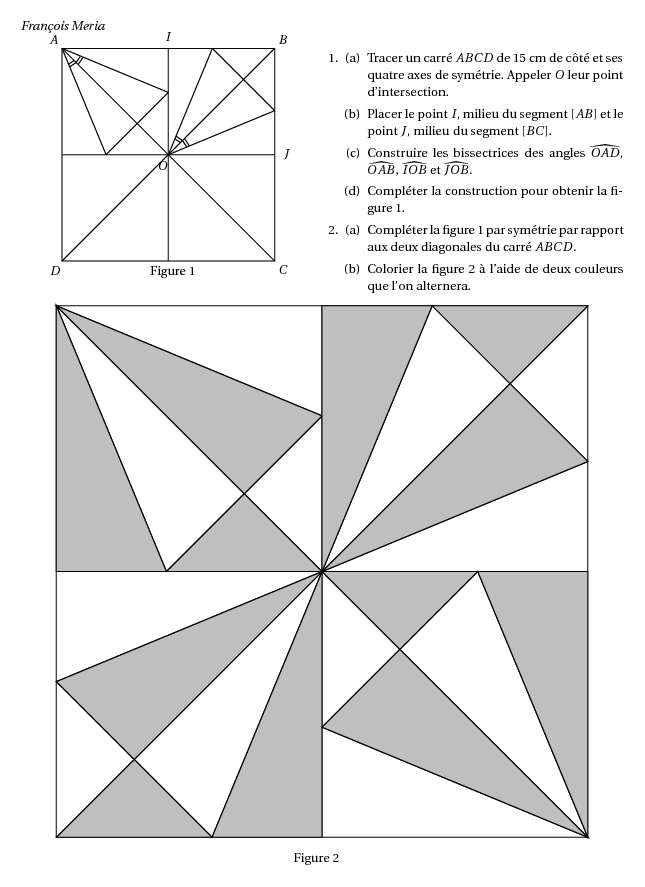
%@Auteur: François Meria\par \begin{multicols}{2} \begin{center} \psset{unit=0.4cm} \pspicture(15,15) \pstGeonode[PointSymbol=none,PosAngle={235,-45,45,135,0,90}](0,0){D}(15,0){C}(15,15){B}(0,15){A}(15,7.5){J}(7.5,15){I} \pspolygon(A)(B)(C)(D) \pstInterLL[PointSymbol=none,PosAngle=-118]{A}{C}{B}{D}{O} \psline(A)(C) \psline(B)(D) \pstGeonode[PointSymbol=none,PointName=none](7.5,0){I1}(0,7.5){J1} \psline(J)(J1) \psline(I)(I1) \pstBissectBAC[linestyle=none,PointSymbol=none,PointName=none]{D}{A}{O}{M1}% \pstInterLL[PointName=none,PointSymbol=none]{A}{M1}{J}{O}{T1}% \psline(A)(T1) \pstBissectBAC[linestyle=none,PointSymbol=none,PointName=none]{O}{A}{B}{M2}% \pstInterLL[PointName=none,PointSymbol=none]{A}{M2}{I}{O}{T2}% \psline(A)(T2) \psline(T1)(T2) \pstMarkAngle[MarkAngleRadius=1.2]{T1}{A}{O}{} \pstMarkAngle[MarkAngleRadius=1.4]{T1}{A}{O}{} \pstMarkAngle[MarkAngleRadius=1.4]{O}{A}{T2}{} \pstMarkAngle[MarkAngleRadius=1.6]{O}{A}{T2}{} \pstBissectBAC[linestyle=none,PointSymbol=none,PointName=none]{B}{O}{I}{N1}% \pstInterLL[PointName=none,PointSymbol=none]{O}{N1}{I}{B}{P1}% \psline(O)(P1) \pstBissectBAC[linestyle=none,PointSymbol=none,PointName=none]{J}{O}{B}{N2}% \pstInterLL[PointName=none,PointSymbol=none]{O}{N2}{J}{B}{P2}% \psline(O)(P2) \psline(P1)(P2) \pstMarkAngle[MarkAngleRadius=1.2]{B}{O}{P1}{} \pstMarkAngle[MarkAngleRadius=1.4]{B}{O}{P1}{} \pstMarkAngle[MarkAngleRadius=1.4]{P2}{O}{B}{} \pstMarkAngle[MarkAngleRadius=1.6]{P2}{O}{B}{} % fin de la première partie de la construction \put(6.2,-1){Figure 1} \endpspicture \end{center} \par\columnbreak\par \begin{enumerate}[1.] \item \begin{enumerate}[(a)] \item Tracer un carré $ABCD$ de $15$~cm de côté et ses quatre axes de symétrie. Appeler $O$ leur point d'intersection. \item Placer le point $I$, milieu du segment $[AB]$ et le point $J$, milieu du segment $[BC]$. \item Construire les bissectrices des angles $\widehat{OAD}$, $\widehat{OAB}$, $\widehat{IOB}$ et $\widehat{JOB}$. \item Compléter la construction pour obtenir la figure 1. \end{enumerate} \item \begin{enumerate}[(a)] \item Compléter la figure 1 par symétrie par rapport aux deux diagonales du carré $ABCD$. \item Colorier la figure 2 à l'aide de deux couleurs que l'on alternera. \end{enumerate} \end{enumerate} \end{multicols} \begin{center} \psset{unit=1cm} \pspicture(15,15) \pstGeonode[PointSymbol=none,PointName=none,PosAngle={235,-45,45,135,0,90}](0,0){D}(15,0){C}(15,15){B}(0,15){A}(15,7.5){J}(7.5,15){I} \pspolygon(A)(B)(C)(D) \pstInterLL[PointSymbol=none,PointName=none,PosAngle=50]{A}{C}{B}{D}{O} \psline(A)(C) \psline(B)(D) \pstGeonode[PointSymbol=none,PointName=none](7.5,0){I1}(0,7.5){J1} \psline(J)(J1) \psline(I)(I1) \pstBissectBAC[linestyle=none,PointSymbol=none,PointName=none]{D}{A}{O}{M1}% \pstInterLL[PointName=none,PointSymbol=none]{A}{M1}{J}{O}{T1}% \psline(A)(T1) \pstBissectBAC[linestyle=none,PointSymbol=none,PointName=none]{O}{A}{B}{M2}% \pstInterLL[PointName=none,PointSymbol=none]{A}{M2}{I}{O}{T2}% \psline(A)(T2) \psline(T1)(T2) \pstBissectBAC[linestyle=none,PointSymbol=none,PointName=none]{B}{O}{I}{N1}% \pstInterLL[PointName=none,PointSymbol=none]{O}{N1}{I}{B}{P1}% \psline(O)(P1) \pstBissectBAC[linestyle=none,PointSymbol=none,PointName=none]{J}{O}{B}{N2}% \pstInterLL[PointName=none,PointSymbol=none]{O}{N2}{J}{B}{P2}% \psline(O)(P2) \psline(P1)(P2) % fin de la première partie de la construction \pstOrtSym[PointName=none,PointSymbol=none]{B}{D}{T1}[Q1] \pstOrtSym[PointName=none,PointSymbol=none]{B}{D}{T2}[Q2] \pspolygon(Q1)(Q2)(C) \pstOrtSym[PointName=none,PointSymbol=none]{A}{C}{P1}[R1] \pstOrtSym[PointName=none,PointSymbol=none]{A}{C}{P2}[R2] \pspolygon(R1)(R2)(O) % coloriage \pstInterLL[PointName=none,PointSymbol=none]{T1}{T2}{O}{A}{S} \pspolygon[fillstyle=solid,fillcolor=lightgray](A)(T2)(S) \pspolygon[fillstyle=solid,fillcolor=lightgray](O)(T1)(S) \pspolygon[fillstyle=solid,fillcolor=lightgray](A)(J1)(T1) \pstInterLL[PointName=none,PointSymbol=none]{P1}{P2}{O}{B}{S1} \pspolygon[fillstyle=solid,fillcolor=lightgray](O)(P1)(I) \pspolygon[fillstyle=solid,fillcolor=lightgray](O)(S1)(P2) \pspolygon[fillstyle=solid,fillcolor=lightgray](P1)(S1)(B) \pstInterLL[PointName=none,PointSymbol=none]{R1}{R2}{O}{D}{U} \pspolygon[fillstyle=solid,fillcolor=lightgray](O)(R1)(U) \pspolygon[fillstyle=solid,fillcolor=lightgray](D)(U)(R2) \pspolygon[fillstyle=solid,fillcolor=lightgray](R2)(O)(I1) \pstInterLL[PointName=none,PointSymbol=none]{Q1}{Q2}{O}{C}{U1} \pspolygon[fillstyle=solid,fillcolor=lightgray](Q1)(U1)(C) \pspolygon[fillstyle=solid,fillcolor=lightgray](O)(U1)(Q2) \pspolygon[fillstyle=solid,fillcolor=lightgray](Q2)(J)(C) \put(6.7,-0.7){Figure 2} \endpspicture \end{center}